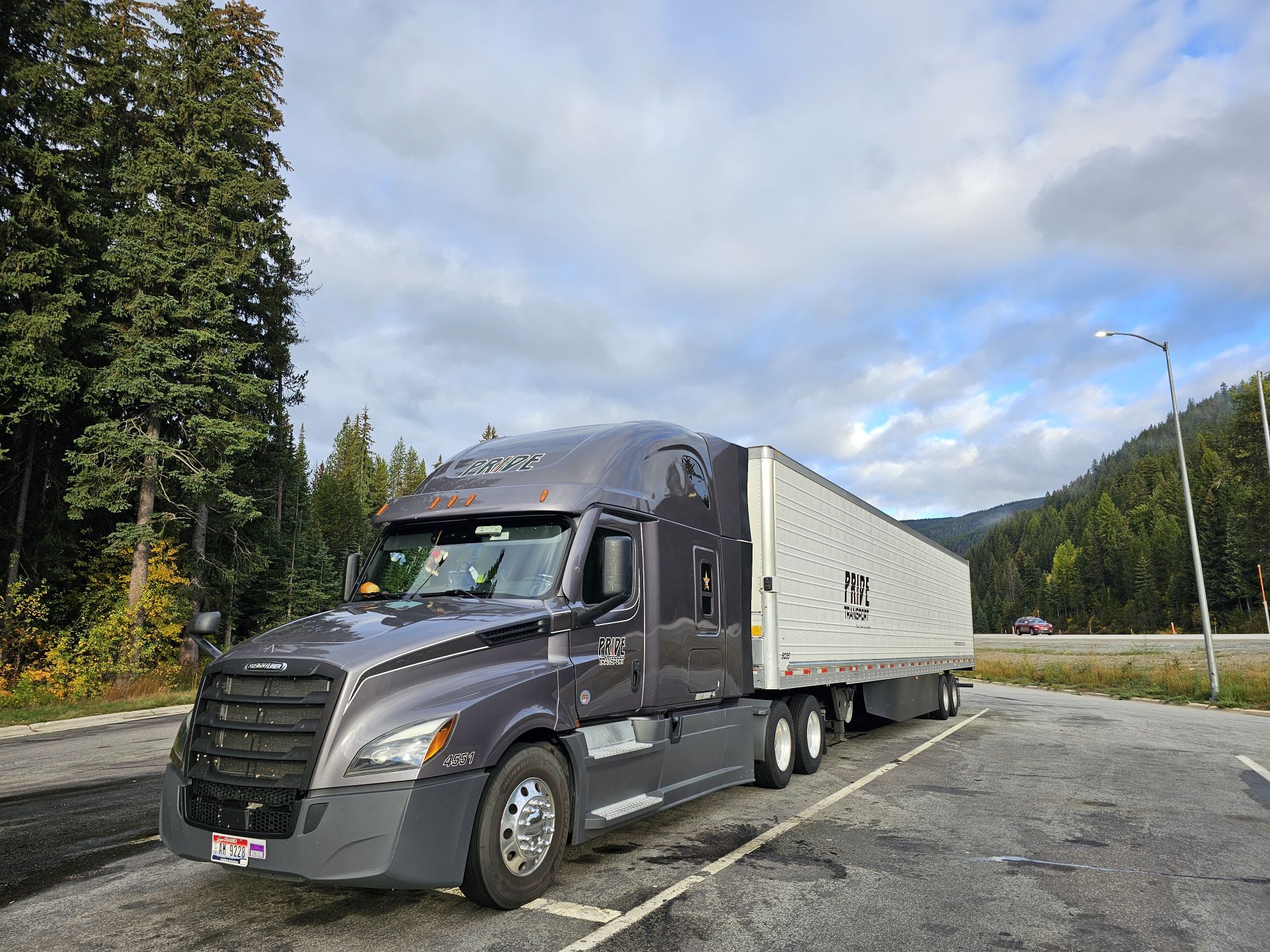by Pride Transport | Oct 15, 2025
The journey to becoming a professional driver often starts with a big decision, and sometimes, a big price tag. For many aspiring drivers, the cost of CDL training is a real barrier. Depending on your state and the school, full training can cost anywhere from $3,000 to $10,000 or more once you factor in all the smaller expenses. Fortunately, you don’t always have to shoulder that burden alone.
Whether you're a new driver exploring your options or someone ready to commit to the career, there are real, reliable ways to pay for CDL training. From company-sponsored training to government grants, scholarships, and even veteran benefits, there’s a path forward that fits your situation.
Budget Beyond Tuition
When many people think of “CDL training cost,” they assume it’s just tuition, but that’s only part of the expense. To make a realistic budget, you need to account for several additional costs that can catch new drivers off guard if they aren’t prepared. Here’s a breakdown of common line items you should plan for, and why they matter.
Permit and licensing fees
Before you begin behind‑the‑wheel instruction, many states require you to pass a knowledge/permit test and pay licensing fees. Those might be $50 to $150, depending on your state.
Physical exam and medical certificate
To qualify for a CDL, you must pass a DOT physical, covering vision, hearing, blood pressure, and more, and obtain a medical certificate. That exam can cost $50 to $150 or more, depending on your provider and location.
Drug testing and background checks
Many training programs and employers require drug screening and possibly additional background checks. Those can run $20 to $100 or more, depending on how many panels or checks are required.
Books, manuals, uniform, and supplies
You’ll often receive a textbook, manual, safety gear (vest, hard hat, etc.), and maybe exam prep materials. Together, these might add $100 to $300.
Lodging, meals, and travel
If the program is out of town, you may need to travel to the school, pay for lodging, and eat meals. Even a 2 to 4 week program can add hundreds or over a thousand dollars in food and lodging costs.
Licensing test fees and retest fees
After training, you’ll still pay the official CDL skills test and license issuance fees. If you fail a portion and retake, additional fees apply.
When you add all of those “extras” to the base tuition, the total cost can climb significantly. That’s why finding the right funding matters, because it’s not just about getting in the door, it’s about making sure you can finish strong without financial stress. Funding sources that fully cover “tuition and related costs” are the most valuable by including these ancillary (but real) costs.

Where You Can Get Funding For CDL Training:
- Scholarships
- Military & Veteran Funding
- Company-Sponsored CDL Training
- Private Loans, Pell Grants & Alternative Funding
Workforce Grants & WIOA: Timing, Standards, and How It Works
One of the most powerful paths is through workforce development grants, especially under the Workforce Innovation and Opportunity Act (WIOA). But to use it well, you need to understand not just eligibility, but timing and performance requirements.
How WIOA funding works
WIOA is federal law that supports training in high‑demand occupations. States distribute those funds through local job centers or workforce boards.
When you apply, a job center counselor may fund your training if you qualify (unemployed, underemployed, dislocated worker, etc.). But your chosen school must often be on the Eligible Training Provider (ETP) list, that is, approved under WIOA in your state. States impose performance and outcome standards on training providers as part of WIOA’s Section 122(b).
Those performance standards (for training providers) are linked to WIOA’s accountability measures, known as the “six primary indicators” under Section 116(b)(2). These include employment rate in the second quarter after exit, employment in the fourth quarter, credential attainment, measurable skills gain, median earnings, and “effectiveness in serving employers.”
As of March 25, 2024, WIOA adopted a final rule that defines the “Effectiveness in Serving Employers” measure explicitly as retention with the same employer.
So when you see “standards” in funding programs, that’s what is meant: performance thresholds providers must meet to stay eligible for funding under WIOA.
Timing, lead time, and schedule constraints
Because WIOA funds flow through states and local programs, you often cannot start training immediately. Local boards require approval, paperwork, verification, and provider vetting.
WIOA funds become available for obligation at specific times in the federal fiscal/calendar structure. According to federal regulations, WIOA Title I funds are generally available on July 1 in the fiscal year for which appropriation is made.
In practice, many applicants report needing 4 to 8 weeks of lead time from the initial job center meeting to funding approval and school start. (This accounts for eligibility interviews, income/identity verification, and training provider vetting). Because those delays exist, you should plan your application at least 6 to 8 weeks ahead of your target training start date.
In short: don’t wait until the week before class to apply. Start your WIOA application two months ahead to allow for delays.
What your funding is tied to
Once approved, WIOA funds often hinge on your meeting attendance, satisfactory progress, and compliance with program rules. If you drop out or fail classes, funding may be withdrawn. That is tied to performance accountability: the state must ensure your training is effective and you are making progress toward employment.
Also, if your school is delisted as an Eligible Training Provider (for dropping performance below standards), future funding may be blocked. States use WIOA Section 122(b) to evaluate providers’ continued eligibility.
Because of all this, your role as a student is not passive: you must meet all attendance/grade requirements, adhere to program rules, and stay in good standing.
Scholarships for CDL Students
Scholarships remain one of the cleanest ways to reduce your cost because they do not require payback. But in trucking, they are less abundant and more competitive. Still, the right ones can meaningfully shrink your gap.
For instance, Women in Trucking Foundation offers scholarships to female driver candidates, and Driver Resource Center’s Future of Trucking sometimes has scholarship openings for CDL students. Many state trucking associations operate local scholarships for individuals entering the trucking industry.
When applying, submit your application early (often 3 to 4 months before training starts), include your personal statement, references, proof of enrollment intent, and any community or work history. Because awards may open and close months before your training begins, if you wait too late you risk missing deadlines.
Military & Veteran Funding
If you’ve served in the military, you can often tap substantial support for CDL training if your school qualifies with the VA.
The Post‑9/11 GI Bill® and Montgomery GI Bill® allow you to apply benefits toward vocational or technical training, including commercial driving, when the provider is VA-approved. You can use the VA’s GI Bill Comparison Tool to check whether your candidate CDL school is approved.
Beyond that, veterans with service-connected disabilities may use Vocational Rehabilitation & Employment (VR&E) to secure funding for training, and this program may also handle case management and job placement after licensing.
Because these benefits often require paperwork and approval, you’ll want to initiate VA benefit verification at least 4 to 6 weeks before you intend to start training, to guard against delays in benefit processing.
Company-Sponsored CDL Training: Agreements & Risks
If your grant and scholarship sources don’t fully cover your cost, company-sponsored training is a common fallback. Under that model, a carrier pays your tuition (or reimburses it) in exchange for your agreement to drive for them for a fixed period. The major advantage is that you often can enter training without paying anything up front. When evaluating a company-sponsored CDL training contract, it’s important to look beyond the “free tuition” headline and understand exactly what the agreement entails. One of the first things to clarify is the length of your required driving commitment after training. Many carriers require anywhere from six months to two years of service to satisfy the terms. Leaving early often triggers a financial penalty, so you’ll also want to understand how repayment is calculated if you decide to part ways before your contract is fulfilled. Some companies deduct the full cost of training, while others prorate the amount based on how long you stayed.
You should also ask for a full breakdown of what is considered “training cost” under the agreement. Is it strictly tuition, or does it include additional fees such as supplies, lodging, administrative charges, or testing expenses? In some cases, drivers have been surprised to find that the total cost they’re on the hook for includes more than just instruction. In addition, clarify whether non-tuition costs, like fuel, personal safety gear, or onboarding materials, are deducted from your pay during or after training.
Another key point is whether the company offers any stipend or compensation during the training period. Some programs are unpaid until you graduate and begin hauling loads, while others provide a modest weekly allowance to help cover basic living expenses. Finally, don’t forget to ask about your future assignments. Will you be guaranteed consistent miles, a specific route type, or access to certain regions once you’re placed in a truck? Understanding where you’ll be driving, and how often, can make a major difference in whether the contract is truly worth it.
Contract terms can vary widely, so you should review them clause by clause before signing.
Private Loans, Pell Grants, and Alternative Funding
When your other funding sources leave a gap, these options can help, but they carry greater risk.
Private or Career-Training Loans & School Installment Plans
Some technical schools partner with private lenders offering career training loans. Others allow installment payments over the course of training. But these loans often carry high interest rates, aggressive repayment schedules, and no grace period.
These loans should be your last resort to fill the residual gap after grants, scholarships, and sponsorships.
Pell Grants & Title IV Aid
Pell Grants are federal funds for low-income students and are awarded via FAFSA. Some community colleges or technical schools offer CDL instruction and participate in Pell / Title IV programs, if they are accredited and approved. If your school qualifies, Pell grants can cover a substantial portion of tuition.
However, many private CDL schools do not participate in Title IV programs, making Pell inapplicable. Always confirm whether your intended CDL school is Pell-eligible, or whether it holds a Title IV eligibility status.
Choosing the Right Combination & Managing Risk
You may wind up mixing multiple funding sources: a smaller scholarship, WIOA grant, veteran benefit, and a modest loan. The goal is to minimize debt and obligations.
When comparing options, keep these principles in mind:
- Prioritize non‑repayable funds first (grants, scholarships, VA benefits)
- Evaluate contract obligations carefully to understand exactly how much you owe and under what conditions
- Be realistic about timelines. Don’t assume funding is instant
- Understand performance standards (attendance, grades, progress) that your funding depends on
- Stay organized: save all paperwork, approvals, contracts, and communication
- Always confirm your CDL school is approved for your intended funding source
Smart Starts Make Strong Careers
Funding your CDL is as much about careful planning as it is about resources. The difference between starting your career with peace of mind or debt stress often comes down to how early and smartly you plan.
At Pride Transport, we respect drivers who start with discipline and planning. If you complete training and earn your CDL, we welcome you to apply to drive with us. We offer strong pay, modern equipment, and support that lets you focus on performance. When you’re ready, you can explore our driver opportunities. Drive for Pride.
